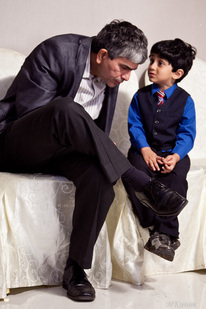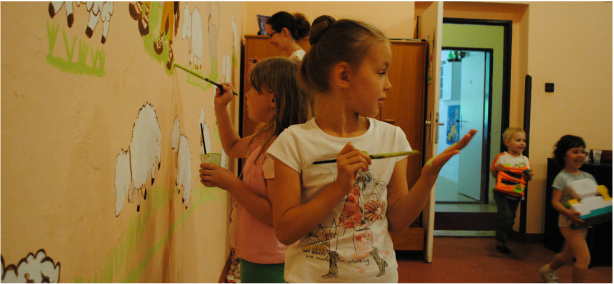|
Adapted excerpts from Parents Magazine Many parents think that it’s premature to teach values to a toddler or preschooler. But that’s a misconception. Here are five values that all children should develop by their fifth birthday, and some easy ways to make them stick. Value #1: Honesty Help kids find a way to tell the truth The best way to encourage truthfulness is to be truthful yourself. Consider this story: Carol decided to limit the number of play dates between her 3-year-old son, Chris, and his friend Paul. The boys had been fighting a lot recently, and Carol thought they should spend some time apart. So when Paul’s mother called one afternoon to arrange a get-together, Carol told her that Chris was sick. Overhearing this, her son asked, “Am I sick, Mommy? What’s wrong with me?” Carol, taken aback by her son’s frightened look, told him she had only said he was sick because she didn’t want to hurt Paul’s mother’s feelings. Carol then launched into a complicated explanation of the distinctions between the various types of lies, and Chris was confused. All he understood was that fibbing is sometimes okay—and that, in fact, it’s what people do. Your child takes his cues from you, so it’s important that you try to avoid any kind of deception, even a seemingly innocent one. Carol would have been better off saying, “This isn’t a good day for a play date. I’m concerned that the boys were fighting so much last week. I think they need a break.” Even if being honest isn’t always easy or comfortable, you—and other people—will always feel better if you tell the truth. Value #2: Justice Insist that children make amends At a recent family gathering, Amy and Marcus, 4-year-old cousins, were making castles out of wooden blocks. Suddenly, Amy knocked over Marcus’s castle, and he started to cry. Witnessing the scene, Amy’s father chided his daughter and ordered her to apologize. Amy dutifully said, “I’m sorry.” Then her dad took her aside and asked, “Do you know why you pushed over his blocks?” She told him that she was mad because Marcus’s castle was bigger than hers. The dad told her that though this was no excuse for destroying her cousin’s castle, he could understand her feelings. He then sent her back to play. The father’s reaction was similar to that of many psychologically savvy parents: He wanted his daughter to identify and express her feelings and to understand why she behaved as she did. That’s okay, but it isn’t enough. Saying “I’m sorry” is pretty easy for a child, and it lets her off the hook without forcing her to think. Having a child make amends in a proactive way conveys a much stronger message. If you’re aware that your child has acted badly toward someone, help him think of a way to compensate. Maybe he can give one of his trucks to a playmate whose toy he has damaged. Perhaps he could draw a picture for his sister after teasing her all day. In Amy’s case, she could have been encouraged to help Marcus rebuild his castle. By encouraging your child to make such gestures, you emphasize the importance of treating people fairly—an essential value that will one day help her negotiate the complicated world of peer-group relationships. Value #3: Consideration Teach them to think about others’ feelings Anne was frustrated because her daughters, ages 3 and 4, ended up whining and fighting every time she took them grocery shopping. “I finally told them that we needed to figure out how to do our shopping without everyone, including me, feeling upset,” Anne says. The mom asked the girls for suggestions on how to make the trip to the grocery store a better experience for all. The 4-year-old suggested that they bring snacks from home so they wouldn’t nag for cookies. The 3-year-old said she would sing quietly to herself so she would feel happy. The girls remembered their promises, and the next trip to the supermarket went much more smoothly. Leaving the store, the younger girl asked, “Do you feel really upset now, Mommy?” The mother assured her that she felt just fine and remarked how nice it was that nobody got into an argument. Do these small problem-solving exercises actually help a child learn the value of consideration? You bet. Over time, even a young child sees that words or actions can make another person smile or feel better, and that when she’s kind to someone else, that person is nice to her. This feedback encourages other genuine acts of consideration. Value #4: Determination Encourage them to take on a challenge Determination is a value that you can encourage from a very young age. A powerful way to help kids develop determination is to encourage them to do things that don’t come easily—and to praise them for their initiative. If your son is shy, for instance, quietly encourage him to approach kids on the playground, even if it makes him feel nervous and scared. If your daughter gets angry quickly, teach her strategies (such as counting to ten or taking a deep breath) for holding back a temper tantrum. Congratulate kids when they manage to do things that are difficult for them. The child who hears “Good for you, I know that was really tough!” is bolstered by the recognition and becomes even more determined to keep trying. Value #5: Love Be generous with your affection Parents tend to think that children are naturally loving and generous with their affection. This is true, but for loving sentiments to last, they need to be reciprocated. It’s chilling to realize that over the course of a typical busy day, the phrase “I love you” is probably the one that a child is least likely to hear. Let your child see you demonstrate your love and affection for the people in your life. Kiss and hug your spouse when the kids are around. Talk to your children about how much you love and appreciate their grandparents, aunts, uncles, and cousins. And, of course, don’t let a day pass without expressing your affection for your child himself. Show your love in unexpected ways: Pack a note in his lunch box. Tape a heart to the bathroom mirror so he’ll see it when he brushes his teeth. Give her a hug—for no reason. Don’t allow frantic morning drop-offs or hectic afternoon routines squeeze loving gestures out of your day. I can practically guarantee you that the more you say “I love you” to your child, the more your child will say “I love you” back. The more hugs and kisses you give, the more your home will be filled with love and affection.—And when our children feel free to express their love to us, we instill in them perhaps the greatest value of all. Courtesy of Motivated! magazine. Used with permission. Photo by Yogesh Kumar Jaiswal via Flickr.
0 Comments
Many Christians choose not to observe Halloween. As one of the most popular holidays in our culture—for some more celebrated than Christmas—it can present a challenge for Christian families, especially when children are involved. Although I won't discuss here all the "whys" and "why nots," and what the Bible says about Halloween, I will offer some fun and practical alternatives to enjoy this year with your family.
Read more
want-want-want, spend-spend-spend trap that has been set for them. In this kind of atmosphere, how are parents to teach their children the value of saving? Start Early Just as teaching a child to choose healthy foods starts at a very young age, helping a child learn how to save should also start early. As soon as children become aware of the process of exchanging money for items they want, they are ready to understand the basics of saving. Because very young kids live in the “now”, don’t start out with expectations of building a college savings with them—they simply can’t identify with goals that are so far-reaching. Start with a Moneybox Instead, start with a little moneybox where they can see the coins they deposit. With my three kids, I taught them from an early age to save for a special toy or small outing—something that can be accomplished within a few weeks. As a result, one of my son Dylan’s favorite toys remains the Anakin Skywalker figure from Star Wars, because it was the first toy he worked towards buying with his own money. Match their Savings To spur the excitement, parents can match their savings. For every quarter the child puts into the bank, the parents also deposit one. Kids see their savings build quickly that way. It also helps reinforce the value of saving. You are in essence rewarding them for their attempt to save money. You might tape a picture of what they are saving for next to the bank to help them stay focused on why they are saving. Where does their money come from? Simple, with my three I keep a chart with stickers next to the fridge, which they earn for keeping their toys picked up or for helping out with other little daily chores. This reward system lets them learn as they earn. Be creative and make this fun for both the kids and adults. Open a bank account By the time children are in third or fourth grade, they may be ready to open a bank account. It can be very disturbing to a child who is used to seeing their money accumulate in their moneybox to have it suddenly disappear. So, it is up to the parents to teach them how banks work. Their money is being kept some place safe; but it is still theirs! When Dylan was ready to get started we made a point of visiting our local bank so he could see the building in which his money would be kept. Make interest the reward Just as you matched their funds when they were younger, you can make a plan to chip into their savings. Interest rates are so low now, it is difficult for children to see their savings build, so this extra reward for saving helps keep their focus. Sit down and discuss with your kids what portion of their allowance should be put in their savings. Set a minimum percentage that is always devoted to their account. They can always put in more, but should be discouraged from putting in less. You may also want to set rules for withdrawals and the minimum amount kept in the account. The older kids get, the easier it is for them to plan for a goal further in the future. By their early high school years at the latest, they should be setting their sights on college savings and it is something I will be encouraging in my brood. Statistics show that young savers are more likely to go to college, even if that isn’t what they are saving for! Courtesy of Motivated magazine; used with permission. Photo from www.seniorliving.org; used under CC-SA license.
 Dr. Bob Pedrick Coming home from college was usually a joyful occasion for Peggy Painter. But this time she felt a stomach-knotting fear, and each step from the bus stop deepened her anxiety. Peggy's parents were Christians and generally understanding. But the story she had to tell of an unwanted pregnancy, ended by abortion, would both shock and sadden them. Would they hear the anguish in her voice? Would they recognize all she had gone through? Or would they, in their own pain, lash out and condemn her? Peggy's story has a happy ending. Her parents listened. They heard; they felt. And their response showed that they understood her feelings and accepted her. For Peggy, it meant the beginning of a new life. Peggy's parents not only rekindled her smothered life but focused attention on her future opportunities rather than past failures. They exhibited what we call responsive listening--a process of listening with a person, not just to or about him. Responsive listening restrains the temptation to judge or give advice. Responsive listening helps a person clarify and communicate his feelings. It creates a climate of understanding, reduces defensiveness, and clears the way to positive changes in behavior. "I Want to Understand You" Responsive listening is not an easy skill to acquire. It takes practice. It means attaining some verbal dexterity. More important, it begins with a caring attitude. Responsive listening presupposes that parents really want to know what their children have to say. It does not necessarily mean agreeing with them. Rather, it is an attitude in which a parent says, "I want to thoroughly understand--and let you know I understand--what you say before I respond." Once the parent understands the message, he has the option to agree or disagree. The effectiveness of our hearing apparatus may get us into or out of trouble, but we're not talking about hearing. Listening is something else. Listening is how we comprehend and react to what we hear. Through extensive research, Xerox Corporation has discovered that most people operate at an efficiency level of only about 25 percent in general listening situations. If similarly low levels of attentiveness are typical of family relations, then many crises may well be traced to poor perceptions of what someone else said. Usually when our children come to us, we respond with some kind of verbal or nonverbal message, but the messages we send often do not achieve the desired results. As a result of his experience with parent training courses, one researcher found that over 90 percent of parental responses to children fall into one of twelve nonproductive categories: 1. Questioning 2. Judging 3. Lecturing 4. Ordering or commanding 5. Warning 6. Name calling 7. Sympathizing 8. Probing 9. Preaching 10. Advising 11. Agreeing 12. Withdrawing These twelve response categories often reap undesirable results, although there are always exceptions to this general rule. Children, parents and situations vary and cannot be handled in a "rulebook" fashion. Many times, however, these types of responses not only illustrate parent-child dialogue today but are similar to the responses Job's "comforters" gave him several thousand years ago. 1. Questioning: Bildad answers, "Who are you trying to fool? Speak some sense if you want us to answer!" (Job 18:2). Such unnecessarily aggressive questioning often triggers rebellious thoughts and behavior. 2. Judging: Eliphaz answers Job, "It is because of your wickedness! Your sins are infinite!" (Job 22:5). Such commonplace judgmental statements, if made to our children, can breed exaggerated attitudes of guilt, which can become permanently imbedded in their personalities. 3. Lecturing: Again Bildad tells Job, "Read the history books and see--the wisdom of the past will reach you" (Job 8:8,10). Lecturing often makes the unwilling recipient feel inferior, inadequate, or resentful. The good-old-days syndrome illustrated here is especially destructive to good family communication. 4. Ordering or commanding: Now Zophar replies, "Stem this torrent of words. Is a man proved right by all this talk?" (Job 11:2). Or, "Shut up!" If repeated often enough, this command can destroy mutual respect. 5. Warning: Bildad warns Job, "Your bright flame shall be put out" (Job 18:5). A warning is all too often an invitation for a child to test the firmness of the parent's resolve. Do you really mean it? The child will soon find out. 6. Name calling: Eliphaz taunts Job, "You give us all this foolish talk. You are nothing but a windbag" (Job 15:2). Want to destroy a child's self-image quickly? Start calling him names. The first few months of your baby's life can be exhausting for both parent and child. Thankfully, most babies develop regular sleep patterns by the time they are 3 to 6 months old. In the meantime, try these tips for getting your little one to sleep through the night. Getting Immediate Relief
Transitioning to Sleeping through the Night
Establishing a Successful Routine
Text adapted from Wikihow.
By Kelly Palmatier, CompassionateKids.com, adapted Volunteering with children is a great way to help them learn about giving back. Children learn valuable skills, such as communication, organization, and team working, while “on the job”. One benefit of volunteering is that children learn about the concerns of the organization they work with, and what need it fills in the community. Consequently, the children also have an opportunity to remember what to be thankful for. It’s important to work side-by-side with your child, since leading by example has been shown to be the most effective form of teaching. Children who see their parents volunteering are much more likely to believe in the value of working to help others. Working side-by-side with your child has many benefits. It is the most effective way to teach your child the value of helping others, ensures that the child’s presence is a help, not a hindrance to the organization’s staff and other volunteers, and while focused on a task together, may foster deep conversations that may not have occurred otherwise. When choosing a volunteer opportunity, it is important to consider the following: 1. Your child’s interests: If your child is clearly interested in a subject, it may be possible to use that interest as a springboard into volunteering: Children who construct a lot of forts or buildings with blocks may enjoy helping out with a safe, simple renovation project. Children who love animals may enjoy helping animal organizations. Children who enjoy clothes and toys can start a clothing and toy drive for poor kids. Children who like baking can provide cookies to a poor orphanage or a home for the elderly. 2. Your interests: It is also important to consider your own interests as your child will emulate your passion and enthusiasm. 3. Your child’s abilities: If your child is very young, it can be challenging to choose a volunteer opportunity that he/she can actually help with. There are opportunities available that even very young children can do with a little parental guidance, such as helping to bag or box items for those in need, or giving flowers, cookies, or hugs to the elderly. 4. Your abilities: Your child will benefit from seeing you work well in your element. For example, if you are especially skilled at home renovations, you may find a community restoration project to work on. This would allow you to share your skills while demonstrating the relevance volunteering has in regards to different careers and interests. 5. Location, frequency, and duration: Consider the basic logistics of any volunteer opportunity. If the opportunity is close by, a commitment to help on a weekly basis may be fine. If it’s farther away, consider helping on a monthly basis. Your child is learning work ethics from this experience, so ensure you arrive on time, and only cancel or reschedule when you truly have valid reasons and can give plenty of notice. The duration of each volunteer session can vary according to the age of the children. Older children may be fine with a few hours or more, but younger children may need sessions to be short, even forty-five minutes. 6. Staff attitude: Most people will appreciate your instilling a volunteer ethic in children at a young age, but some will focus more on the noise level or other potential distractions. It is important to consider the effect others’ attitudes have on your child. If a child feels like a hindrance, volunteering could end up like a chore rather than a joy. The effort put into organizing volunteer opportunities for your children can provide a lifetime of benefit for both the kids involved and for society. Resources for finding volunteer opportunities
Article courtesy of Motivated magazine. Used with permission. Photo by David Katarina via Flickr.
Koos Stenger When our son Pete was three, he was diagnosed with leukemia, and from one moment to the next, our lives changed drastically. There are no instruction manuals that can prepare you for how to cope when your child is facing a life-threatening disease. Even though we found shelter in the loving arms of Jesus, our tender Shepherd, we still had to find a way to face the scary events of the following weeks and months. Finally, there was light at the end of the tunnel: The doctors pronounced Pete healed. But in reality the challenge was not over; years later, the ugly monster raised its foul head again, not once but twice. When the cancer returned the first time, we were in South Africa, an unfamiliar country with a different language, culture, and medical system from what we were used to. But the fears and pain were the same, along with the interminable waiting for the tiniest signs of improvement. The improvement did come, and again it seemed he was cured … until three years later, we were stunned to discover that our son’s cancer had returned yet again. Still only ten years old, Pete was facing his third bout with the illness. We cried and agonized. We didn’t understand God’s reasons, but we felt His presence ever by our side. I was pretty sure I could relate to how the apostle Paul must have felt when he wrote, “We are pressed on every side by troubles, but we are not crushed. We are perplexed, but not driven to despair. We are … never abandoned by God. We get knocked down, but we are not destroyed.” And so once more we held on desperately. Back at the hospital, the doctor was explaining that the best possibility for permanent healing was a bone marrow transplant, but everyone in our family had already been tested. None of us were a match. “Let’s test again,” he advised. The next week the doctor met us with a smile. “Your youngest son is a close enough match,” he said. It was no instant victory. Again it took days, weeks, and months before Pete was out of danger. But he pulled through and has been cancer-free for the past ten years. How do you survive a crisis? You hold the hand of the Shepherd, moment by moment, hour by hour, day by day. Article courtesy of Activated! magazine. Used with permission.
By Tiffany Roget, eHow Contributor 1. Story time One quick and easy way to convey the importance of perseverance to children is to read stories that teach this quality. Request that children act out the characters, performing their physical actions, as you read the story aloud. Drive home the idea you are trying to convey by having coloring pages accompany each story, or activity worksheets on hand for the children to complete after story time ends. A few examples of applicable books include “The Tortoise and the Hare” and “The Little Engine That Could”. 2. Collage action Engage children of any age with an art project that enables them to express their feelings about perseverance in a creative way. Give each child one piece of colored art paper, and instruct them to draw a line down the center of the page. Label the top of the left column with “Persevering Rocks!” and the right column with “Not Persevering!” Offer the children a variety of magazines to choose from and instruct them to search the pages for interesting images that reflect these two ideas. Glue images to the applicable side of the paper, allowing for overlapping if desired for additional visual artistic expression. Ask the children to write a couple sentences on the back of their collage that reflects a time they personally persevered, and applaud them for their actions. 3. Host puppet shows Kids love puppets and as a result enjoy receiving information from these friendly characters in a non-threatening manner. Take advantage of this situation by hosting puppet shows and have the children take turns acting out the plays. Offer up scripts that reflect a young person facing challenging circumstances, choices, or obstacles, and cover how they persevere through the difficult situation. You might consider finding stories and quotes that offer inspiring messages regarding learning how to persevere and integrate these stories and characters into your plays. 4. Play games Many games offer the opportunity to help children learn about the art of perseverance, and practice skills to acquire it. Croquet is one game where players are required to hit a ball with a mallet through small metal arches stuck into the ground. Like golf, the less strokes it takes you to get a ball through an arch, the better your chances to win the game. The first person to pass through all the arches and successfully tap the end post wins. This game takes concentration, patience, and an ability to be able to calmly plan your next move. Children often don’t realize that while they are playing they are simultaneously practicing how to persevere every time their ball doesn’t go where they intended it to. Help children learn the importance and benefits of persevering and simultaneously enable them to work on establishing self-discipline. Both of these qualities enable young people to develop self-confidence and grow into capable teens and adults who can adequately make healthy, personal decisions. Set small goals for kids to accomplish and praise them when they meet their intended result. A homebased chart, where they receive gold stars for accomplished goals, keeps wandering minds motivated. Courtesy of Motivated! magazine. Used with permission. Image via Kendall Lister via Flickr.
|
Categories
All
Archives
March 2024
LinksFree Children's Stories |








 RSS Feed
RSS Feed
